Water Resources Evaluation and Sustainability Considering Climate Change and Future Anthropic Demands in the Arequipa Region of Southern Peru
Abstract
:1. Introduction
2. Study Area and Methods
3. Results and Discussion
3.1. Data Gathering and Management
Reservoir Characterization
- -
- There is only one reservoir (Pasto Grande) in the Tambo watershed, which has two outlets. The first outlet is a channel that diverts the water to the Moquegua watershed, which is located outside of the basins of interest. The second outlet diverts the water to the Tambo watershed, which receives the spillway flows and an annual volume of 8.2 Hm3 between September and December [33].
- -
- There are four reservoirs in the Camana watershed, with three of them regulating water supply for the upper Quilca watershed through the “Pañe-Colca” channel, while one regulates water to be diverted downstream to the middle Quilca watershed for irrigation purposes (Majes Irrigation District).
- ○
- The Pañe reservoir has natural inflows and two regulated outflows. The first outflow drifts the water toward the “Pañe-Colca” channel, while the second one diverts the spillway to the Camana watershed through the natural stream network.
- ○
- The Bamputañe reservoir has natural inflows and contributes all its flows to the “Pañe-Colca” channel.
- ○
- The Dique reservoir has three main inflows: (1) the first one is through the “Pañe-Colca” channel, which brings the water from the Pañe and Bamputañe outflows; (2) the second one corresponds to a water intake in the “Antasalla” channel, and (3) the third one has natural inflows coming from the upstream rivers of the Camana watershed. Moreover, it has two outlets, one that diverts the water to the “Zamacola” channel (continuation of the “Pañe-Colca” channel that diverts the water towards the Quilca watershed), and one that routes the spillways to the Camana watershed through what would be the natural routing without infrastructure.
- ○
- The Condorma reservoir is the biggest reservoir concerning storage in the Camana watershed. It has a natural inflow which is the contribution of its natural drainage area, the spillways from the Pañe reservoir, and the spillways of the Dique reservoir. There is only one outflow for scheduled releases and spillways, and routes the outflow for where it would be the natural routing without infrastructure.
- -
- For the Quilca watershed, there are also four reservoirs, which have a similar distribution compared to the Camana watershed; three reservoirs are located upstream, while the one downstream gathers the flows of the other three.
- ○
- The Challhuanca reservoir has one natural inflow and only one outflow from where spillway and regulated flows are routed.
- ○
- The Pillones reservoir has two inflows and one outflow. The outflow is through its dam and the inflows come from a tunnel diversion that benefits from the flows coming through the “Zamacola” channel and natural drainage from its basin and the Sumbay one.
- ○
- The “El Frayle” reservoir is similar to the Challhuanca setup, but with a bigger drainage area.
- ○
- The “Aguada Blanca” reservoir receives the outflows from its drainage area, the residual flows left downstream of the Pillones tunnel, and the three aforementioned reservoirs. Regarding its outflows, it has one for regulated outflow and spillway through its dam, and one inner tunnel that diverts flows to a hydroelectric plant (Charcani V), which is located not so far downstream of it.
- ○
- Regarding the Quilca watershed, there is a diversion not so far downstream where the “Zamacola” channel diverts into the Quilca basin, which diverts water into the “Pillones” reservoir. The problem with this diversion is that the remaining downstream flows are not measured and, as a result, the “Aguada Blanca” reservoir calibration will be affected since there is an unmeasured regulated flow (see Figure 2).
3.2. Hydrologic Modeling
3.2.1. Watershed Delineation and Land Use and Soil Classification
3.2.2. Model Set-Up
- When analyzing the simulation setup, it is important to differentiate between drainage areas dominated by streamflows, diversions, and reservoirs (see Figure 5). In the case of drainage areas with reservoirs, a simulation was needed for each, though PRMS allows the simulation of up to four reservoirs at once. One subbasin was needed for each diversion since water transfers were implemented to the entire subbasin and taken out of the resulting subbasin outflow. For the case of streamflow, all could be simulated at once and there was no need to split the simulation based on the number of stream gages, as illustrated in Figure 5.
- 2.
- To speed up the simulations, climate files for each one of the five watersheds were created. Three main variables are dominant in the inverse distance-elevation weighting (IDE) method of PRMS, from which two main variables were adjusted. The first variable (“dist_exp”) is the most important since it provides more weight in the spatial distribution for a certain weather station, while the second one (“prcp_wght_dist”) is a ratio to adjust more weight to distance or elevation, from which 75% percent of weight was given to distance and 25% to elevation. The problem with elevation was the drastic changes in the characteristic topography of the Peruvian Andes, which caused a lot of “noise” in the distribution. To test the first variable, a gridded HRU approach was applied to smooth the distribution of the climate variables. The gridded approach allows seeing a proper distribution of the climate variables compared to the semi-distributed one that is used for the models. The “dist_exp” variable is highly sensitive (i.e., the higher its value, the more influence the weather stations will have in nearby cells). Many values were tested for this parameter and a value of 3.5 was chosen since it smooths the distributions best (see Figure 6). The same values were applied to the five watersheds and Climate by HRU (CBH) files were created.
- -
- The Ocoña watershed has only two stream gages. The Ocoña stream gage is more important since it is located in the lowest elevation, representing a larger portion of the watershed. The Salamanca stream gage contributes around 11 and 4.5% for the dry and wet seasons, respectively.
- -
- For the Camana watershed, the Pañe, Bamputañe, and Dique reservoirs only contribute their spillway flows to the Camana watershed, which is negligible for a given year since it only happens sometimes during the wet season. Condoroma outflows, on the other hand, are highly tied to streamflow measurements in Tuti; Condoroma outflows are 74 and 22% of the Tuti flow for the dry and wet seasons, respectively. Since the Tuti stream gage diverts a big portion of its flows to the Quilca watershed, it contributes more water to the Huatipa station during the wet season (50%) than during the dry one (2%). Additionally, there is a flow loss of around 29% from the Huatipa to the Hacienda Pampata stream gages during the dry season, which could due to a shortage of data in the Hacienda Pampata time series. Huatipa, on the other hand, contributes 73% of Hacienda Pampata flows during the wet season.
- -
- In the Quilca watershed, some external inputs come altogether through the Zamacola channel. The Pañe, Bamputañe, and Dique los Españoles reservoirs contribute 41%, 18%, and 10.35%, respectively. It is important to acknowledge that there are unknown flows from some intakes along the Pañe-Colca channel. The Zamacola channel contributes to the Sumbay stream gage with 82% and 69% for dry and wet seasons, respectively. Moving downstream to the Aguada Blanca reservoir, 53%, 6%, 12%, and 23% of the regular discharges from the reservoir are contributed by the Sumbay, Challhuanca, Pillones, and Frayle diversion/reservoirs, respectively. The last two stream gages in this watershed are the Tingo Grande and Puente del Diablo; it is hard to compare the flows downstream on Puente del Diablo with the Aguada Blanca releases since there are some water uses associated with this stream. There is a flow loss of 30% during the dry season, while for the wet season a one-to-one relationship was found. Meanwhile, for the Tingo Grande flow recording station, there is a contribution of 2% and 8% for the dry and wet seasons, respectively.
- -
- For the Tambo watershed, 1% and 3% are contributed for the dry and wet seasons, respectively, between the Pasto Grande reservoir and the Santa Rosa stream gage.
3.2.3. Model Calibration
- -
- The Salamanca subbasin, located in the Ocoña watershed, from which an NSE of 0.35 was obtained, though only a small percentage of importance was associated with the main stream gage. There was not enough data to catch the dry seasons and, more importantly, different baseflow magnitudes during the dry seasons. The hypothesis associated with this is that this stream gage is located downstream of a glacier (see Figure 12), which by having different melting periods is changing this dynamic. Moreover, some previous studies (e.g., [34]) have tried to calibrate this stream gage but were not successful and lesser performance (NSE = 0.20). A study developed by ANA had better results but the simulation was developed on a monthly basis [22].
- -
- For the Dique los Españoles reservoir, an NSE of 0.15 was achieved. The problem faced in this reservoir was missing inflows from the hydraulic infrastructure surrounding the structure, and probably high groundwater flows since there is a nearby lagoon. Also, there are missing records from the Jancolacoya and Antasalla water intakes (see Figure 2).
- -
- The Aguada Blanca reservoir had the worst calibration statistics. Poor calibration was since the downstream flows coming from the Pillones Tunnel were not recorded, so mass balance errors were obtained when trying to do a mass balance between the flows of the Sumbay stream gage (which is located not so far upstream from the Pillones Tunnel diversion) and the flows being diverted to Pillones. The second and most important reason is the dataset for spillways, from which AUTODEMA and EGASA had different records. Furthermore, when activating the spillway flows, the reservoir volume decreased to zero. Some hypotheses for this could be as follows: (1) higher flows are coming from the Pillones reservoir; (2) the precipitation distribution needs more stations in the drainage area contributing to the reservoir inflows; and (3) the spillways are wrongly measured or summarized, since giving one uniform flow for the spillways for an entire day dried the reservoir, and it is not the same to have a high discharge for 24 h and just for six hours. The year 2012 was the most problematic, where a high precipitation event triggered the spillways and the errors (see Figure 13).
3.3. Future Scenarios: Hydrology and Water Usage
3.3.1. Future Scenarios: Hydrology
3.3.2. Future Scenarios: Water Usage
4. Conclusions and Recommendations
- -
- There is a clear need to have a unified database for all weather-related variables, streamflows, and reservoir data. It has been found that entities such as ANA, National Meteorology and Hydrology Service (SENAMHI), AUTODEMA, and EGASA, among others, have different datasets and the data are not compiled into one master repository. This causes many problems such as not accounting for weather stations from reservoirs included in the PISCO dataset and discrepancies between databases from one entity to another. Similarly, it is important to have the data publicly available in a quality assured and organized format, to ease the difficulty of future analyses. Moreover, information gathered by private entities should also be included and made available to the public. These improvements in data management would be a step forward toward achieving sustainable development not only in the Arequipa Region but also in the entire country.
- -
- For modeling purposes, it is important to include solar radiation measurements in weather stations, especially in areas such as reservoirs and irrigation fields where evaporation and evapotranspiration are a critical piece of the water storage and use evaluation.
- -
- The inclusion of a weather station in the Pasto Grande reservoir would highly improve conceptualization and modeling of this reservoir.
- -
- Based on the climate change analysis, reservoirs such as Condoroma, which buffers all inflows coming from the upstream parts of the Camana watershed, may not be able to mitigate the high flows predicted for SSPs higher than 126. In other words, if the Arequipa Region does not follow the conservative SSP, flooding-related (such as fluvial floods and “huaycos”) problems downstream of the reservoirs could worsen, which is something that has been threatening many communities within sub-watersheds draining to the Pacific Ocean.
- -
- It is encouraged that the PISCO dataset has continuous development. This dataset may not be as accurate as hard data from weather stations but is a product with a good spatial resolution for Peru, derived from raw weather stations data. Moreover, the inclusion of an integrated database, as previously mentioned, would improve its accuracy.
- -
- Given the strong topographical characteristics of Southern Peru, it is recommended to improve the weather stations’ density and data recording, specially in areas where high water storage is present (i.e., reservoirs and their drainage area).
- -
- During model calibration, spillway flows produced unrealistic behaviors for some reservoirs. Thus, it is recommended to record hourly time series of spillway flows since the high magnitude of these flows is not usually constant for an entire day, which made some reservoirs go dry as soon as they were activated.
- -
- Irrigation could be included in the PRMS setup. Land uses associated with irrigation have an HRU identifier. Hence, its inclusion would not be complicated. However, to accomplish this, it would be necessary to monitor irrigation schedules and parameters such as soil moisture and aquifer levels below irrigated areas, which is not currently carried out. Moreover, if an aquifer is generated due to intensive irrigation as in the Majes irrigation district (see [16] for more details), a network of piezometers would be needed to include the groundwater flow direction into the simulation, or more advanced models such as MODFLOW [45] could be linked.
- -
- It would be useful to include local water consumption for usages such as drinking water in the city of Arequipa, but at least a monthly time series would be needed for each included water use. Currently, estimates for use lack sufficient detail for detailed analyses (for example, to enable a focus of future water supply versus demand monthly during the dry season).
- -
- If it is desired to improve reservoir dynamics, for instance, to use water levels in the reservoirs for model calibration), which could significantly improve reservoir response and dynamics, PRMS source code would need to be modified to include rating curves of volume versus elevation. This approach would be beneficial if there was a strong interaction between reservoir and surrounding aquifer or if there were seasonal changes in the surrounding aquifer’s water levels, which would allow the model to analyze the elevation at which water in the reservoirs starts to seep into groundwater storage. This approach would require a network of piezometers to monitor the water table surrounding the reservoir.
- -
- After calibrating the five watersheds, the scarcity of data throughout the study areas was evident. A significant amount of data is missing in the reservoir system of the Quilca watershed. There are many water intakes and channels with unknown flows in the Dique los Españoles reservoir and the Pañe-Colca channel. Moreover, only the flows going towards the Pillones tunnel are known and not the ones going downstream to the Aguada Blanca reservoir. Furthermore, implementing a stream gage upstream of the Aguada Blanca would improve calibration and water accounting since the drainage area for this location has been considered to generate high flows. There is a need for a uniform dataset in all reservoirs and diversions since databases had discrepancies. For instance, the Aguada Blanca reservoir showed a difference of around 50 m3/s (in reservoir spillway flow) between two source institutions that documented the same information. For the rest of the watersheds, there are no specific locations but there is a need for more stream gages and stations, and it would be important to have these near cities or irrigation projects to properly evaluate future impacts.
- -
- It is extremely important to evaluate reservoir sediment deposition against high flows expected with climate change. The actual capacity of the reservoirs is currently unknown, so an evaluation of sediment accumulation is crucial to ensure future water sustainability in the Region. Hydraulic analysis should be performed to evaluate the possible damages to infrastructure and to downstream inhabitants during the increased “huayco” flows.
- -
- A more comprehensive analysis of available groundwaterin the five watersheds would be highly useful to evaluate watershed storage capacity, since it could serve as an additional water supply in the future. Groundwater may represent an important way to store water in the future.
- -
- A holistic evaluation of future water supply and storage options is recommended. Such analysis would include evaluating the construction of new reservoirs, the implementation of aquifer recharge facilities, or other solutions such as natural infrastructure (e.g., constructed wetlands), water treatment options such as recycled water and desalination.
Supplementary Materials
Author Contributions
Funding
Institutional Review Board Statement
Informed Consent Statement
Data Availability Statement
Acknowledgments
Conflicts of Interest
References
- Global Affairs Canada. Addressing Peru’s Climate Challenges with Nature-Based Solutions. Available online: https://www.international.gc.ca/world-monde/stories-histoires/2022/peru-climate-challenges_defis-climatiques-perou.aspx?lang=eng (accessed on 24 November 2022).
- World Bank Group. Peru, Country, Climate, and Development Report. Available online: https://reliefweb.int/report/peru/peru-country-climate-and-development-report-november-2022 (accessed on 23 January 2023).
- UNESCO. Peru Faces a Surge of Climate Migrants. Available online: https://en.unesco.org/courier/2021-4/peru-faces-surge-climate-migrants (accessed on 4 January 2023).
- USAID. Peru Climate Change Fact Sheet. Available online: https://www.climatelinks.org/resources/peru-climate-change-fact-sheet (accessed on 4 January 2023).
- The World Bank. Assessment of the Impacts of Climate Change on Mountain Hydrology. Available online: https://documents1.worldbank.org/curated/en/211461468294364190/pdf/ (accessed on 23 January 2023).
- Lavado-Casimiro, W.; Labat, D.; Guyot, J.; Ardoin-Bardin, S. Assessment of climate change impacts on the hydrology of the Peruvian Amazon-Andes Basin. Hydrol. Process. 2011, 25, 3721–3734. [Google Scholar] [CrossRef]
- Zubieta, R.; Molina, J.; Laqui, W.; Sulca, J.; Ilbay, M. Comparative analysis of climate change impacts on meteorological, hydrological, and agricultural droughts in the Lake Titicaca Basin. Water 2021, 13, 175. [Google Scholar] [CrossRef]
- Mishra, A.K.; Özger, M.; Singh, V.P. Association between uncertainties in meteorological variables and water-resources planning for the state of Texas. J. Hydrol. Eng. 2011, 16, 984–999. [Google Scholar] [CrossRef]
- Irwandi, H.; Rosid, M.S.; Mart, T. Effects of Climate change on temperature and precipitation in the Lake Toba region, Indonesia, based on ERA5-land data with quantile mapping bias correction. Sci. Rep. 2023, 13, 2542. [Google Scholar] [CrossRef]
- Wang, Y.; Zhang, Z.; Allen, E.E.; De La Guardia, L.; Qie, G.; Wu, X.; Zhao, W. An integrated framework to assess climate change impacts on water use for thermoelectric power plants. J. Clean. Prod. 2022, 376, 134271. [Google Scholar] [CrossRef]
- Nguyen, T.; Virdis, S.; Vu, T.B. “Matter of climate change” or “Matter of rapid urbanization”? Young people’s concerns for the present and future urban water resources in Ho Chi Minh City Metropolitan Area, Vietnam. Appl. Geogr. 2023, 153, 102906. [Google Scholar] [CrossRef]
- Orkodjo, T.P.; Kranjac-Berisavijevic, G.; Abagale, F.K. Impact of climate change on future availability of water for irrigation and hydropower generation in the Omo-Gibe basin of Ethiopia. J. Hydrol. Reg. Stud. 2022, 44, 101254. [Google Scholar] [CrossRef]
- Mendoza, J.A.C.; Alcazar, T.A.C.; Medina, S.A.Z. Calibration and uncertainty analysis for modelling runoff in the Tambo River Basin, Peru, using sequential Uncertainty fitting VeR-2 (SUFI-2) algorithm. Air Soil Áter Res. 2021, 14, 117862212098870. [Google Scholar] [CrossRef]
- Coloma, A. Simulación Hidrológica e Hidráulica del río Tambo, Sector Santa Rosa, Distrito de Cocachacra, Provincia de Islay, Departamento de Arequipa. Thesis National University of San Agustin, Arequipa-Perú. 2015. Available online: https://core.ac.uk/download/pdf/162860876.pdf (accessed on 2 November 2022).
- USAID. Quilca-Chili WEAP Model with Refined Strategy. PARA-AGUA Project. Available online: https://pdf.usaid.gov/pdf_docs/PA00N121.pdf (accessed on 3 November 2022).
- Wei, X.; Garcia-Chevesich, P.; Alejo, F.; García, V.; Martínez, G.; Daneshvar, F.; Bowling, L.C.; Gonzáles, E.; Krahenbuhl, R.; McCray, J.E. Hydrologic Analysis of an Intensively Irrigated Area in Southern Peru Using a Crop-Field Scale Framework. Water 2021, 13, 318. [Google Scholar] [CrossRef]
- Daneshvar, F.; Frankenberger, J.; Bowling, L.C.; Cherkauer, K.A.; De Lima Moraes, A.G. Development of strategy for SWAT Hydrologic modeling in Data-Scarce regions of Peru. J. Hydrol. Eng. 2021, 26, 05021016. [Google Scholar] [CrossRef]
- INGEMMET. Hidrogeología de la cuenca del río Quilca—Vitor—Chili (132)—Boletín, Serie H: Hidrogeología, 15. Repositorio Institucional INGEMMET. 2022. 381p. Available online: https://repositorio.ingemmet.gob.pe/handle/20.500.12544/3885 (accessed on 1 November 2022).
- INEI. Estimaciones y Proyecciones de Población por Departamento, Provincia, y Distrito 2018–2020. Available online: https://www.inei.gob.pe/media/MenuRecursivo/publicaciones_digitales/Est/Lib1715/libro.pdf (accessed on 10 April 2023).
- INRENA. Estudio Integral de los Recursos Hídricos en las Cuencas de los ríos Acarí y Yauca: Componente—Estudio Hidrológico de la Cuenca del Río Yauca. Instituto Nacional De Recursos Naturales Dirección General De Aguas Y Suelos. Arequipa, Perú. 2003. 84p. Available online: https://hdl.handle.net/20.500.12543/3317 (accessed on 3 November 2022).
- ANA. Plan de Gestión de Recursos Hídricos en la Cuenca Quilca—Chili. Autoridad Nacional del Agua. Arequipa, Perú.2013. 161p. Available online: https://hdl.handle.net/20.500.12543/10 (accessed on 3 November 2022).
- ANA. Evaluación de Recursos Hídricos en la Cuenca de Ocoña. Autoridad Nacional del Agua. Arequipa, Perú. 2015. 53p. Available online: https://hdl.handle.net/20.500.12543/8 (accessed on 3 November 2022).
- ANA. Evaluación de Recursos Hídricos en la Cuenca Camaná—Majes—Colca. Autoridad Nacional del Agua. Arequipa, Perú. 2015b. 840p. Available online: https://hdl.handle.net/20.500.12543/7 (accessed on 3 November 2022).
- ANA. Estudio Hidrológico de la Unidad Hidrográfica de Tambo. Autoridad Nacional del Agua. Arequipa, Perú. 2019. 208p. Available online: https://hdl.handle.net/20.500.12543/4703 (accessed on 3 November 2022).
- INGEMMET. Estudio Hidrogeológico de la Cuenca del Río Camaná-Majes-Colca. 2021 Repositorio Institucional INGEMMET. 2021. 280p. Available online: https://repositorio.ingemmet.gob.pe/handle/20.500.12544/3163 (accessed on 3 November 2022).
- INGEMMET. Hidrogeología de la Cuenca del Rio Tambo (1318). Regiones Arequipa, Moquegua y Puno. 288p. Instituto Geológico, Minero y Metalúrgico—INGEMMET, Lima (Peru). 2020. Available online: https://hdl.handle.net/20.500.12544/2573 (accessed on 3 November 2022).
- INGEMMET. Estudio Geoambiental en la Cuenca del Río Ocoña. 222p. Instituto Geológico, Minero y Metalúrgico—INGEMMET. 2021. Available online: https://hdl.handle.net/20.500.12544/3167 (accessed on 3 November 2022).
- SNIHR. Sistema Nacional de Información de Recursos Hídricos. 2022. Available online: https://snirh.ana.gob.pe/VisorPorCuenca/ (accessed on 19 October 2023).
- Wilson, M.L.; Tchantchaleishvili, V. The importance of free and open source software and open standards in modern scientific publishing. Publications 2013, 1, 49–55. [Google Scholar] [CrossRef]
- Leavesley, G.H.; Lichty, R.W.; Troutman, B.M.; Saindon, L. Precipitation-Runoff Modeling System; User’s Manual; U.S. Geological Survey, Water Resources Division: Reston, VA, USA, 1983. [Google Scholar] [CrossRef]
- Quiroz, J.A. Arequipa Watershed-Scale Hydrologic Models, HydroShare. 2023. Available online: http://www.hydroshare.org/resource/d06a41bb8a2f435da6c84792403f961a (accessed on 3 March 2023).
- Huerta Astorga, J.L. Proyecto Especial Majes Siguas. AUTODEMA Principales Logros Gerencia Gestión de Recursos Hídricos Setiembre. 2011. Available online: https://cdn.www.gob.pe/uploads/document/file/1325831/AUTODEMA%20-%20Audiencia%2001.pdf (accessed on 4 November 2022).
- Decreto Supremo Nº 002-2008-AG. Reservan Aguas Superficiales a Favor del Proyecto Especial Pasto Grande del Gobierno Regional Moquegua. Diario Oficial El Peruano, 10 January 2008. Available online: https://www.midagri.gob.pe/portal//download/pdf/marcolegal/normaslegales/decretossupremos/DECRETO%20SUPREMO%20N%20002-2008-AG.pdf (accessed on 4 November 2022).
- Santana, A.D. Elaboración de Modelos Hidrológico y de Gestión en la Cuenca del río Ocoña en Perú y Análisis de Resultados. Master’s Thesis, Universitat Politécnica De Valéncia, Valencia, España, 2018. Available online: https://riunet.upv.es/bitstream/handle/10251/98391/01_Memoria.pdf?sequence=1 (accessed on 2 November 2022).
- Imfeld, N.; Sedlmeier, K.; Gubler, S.; Marrou, K.C.; Davila, C.P.; Huerta, A.; Lavado-Casimiro, W.; Rohrer, M.; Scherrer, S.C.; Schwierz, C. A combined view on precipitation and temperature climatology and trends in the southern Andes of Peru. Int. J. Climatol. 2021, 41, 679–698. [Google Scholar] [CrossRef]
- Diario La República. Fuentes de Agua para Ciudades del sur Están en Peligro. 8 Dicember 2019. Available online: https://larepublica.pe/sociedad/2019/12/08/fuentes-de-agua-para-ciudades-del-sur-estan-en-peligro-lrsd/ (accessed on 18 October 2021).
- Diario El Pueblo. Sedimentación de Aguada Blanca incrementó. 23 March 2016. Available online: https://diarioep.pe/sedimentacion-de-aguada-blanca-se-incremento/ (accessed on 18 October 2021).
- INEI. Estado de la Población Peruana. Instituto Nacional de Estadística e Informática, 2020. Available online: https://www.inei.gob.pe/media/MenuRecursivo/publicaciones_digitales/Est/Lib1743/Libro.pdf (accessed on 3 November 2022).
- Perera, D.; Williams, S.; Smakhtin, V. Present and Future Losses of Storage in Large Reservoirs Due to Sedimentation: A Country-Wise Global Assessment. Sustainability 2022, 15, 219. [Google Scholar] [CrossRef]
- Garcia-Chevesich, P. Erosion Control and Land Restoration; Outskirts Press: Denver, CO, USA, 2016; 486p. [Google Scholar]
- Xiong, R.; Zheng, Y.; Feng, H.; Tian, Y. Improving the scientific understanding of the paradox of irrigation efficiency: An integrated modeling approach to assessing Basin-Scale irrigation efficiency. Water Resour. Res. 2021, 57, e2020WR029397. [Google Scholar] [CrossRef]
- Knox, J.W.; Kay, M. Water Regulation, crop production, and Agricultural water Management—Understanding farmer perspectives on irrigation efficiency. Agric. Water Manag. 2012, 108, 3–8. [Google Scholar] [CrossRef]
- Maghchiche, A.; Haouam, A.; Immirzi, B. Use of polymers and biopolymers for water retaining and soil stabilization in arid and semiarid regions. J. Taibah Univ. Sci. 2010, 4, 9–16. [Google Scholar] [CrossRef]
- Li, W.; An, M.; Wu, H.; An, H.; Huang, J.; Khanal, R. The local coupling and telecoupling of urbanization and ecological environment quality based on multisource remote sensing data. J. Environ. Manag. 2023, 327, 116921. [Google Scholar] [CrossRef]
- Hughes, J.D.; Russcher, M.J.; Langevin, C.D.; Morway, E.D.; McDonald, R.R. The MODFLOW Application Programming Interface for simulation control and software interoperability. Environ. Model. Softw. 2022, 148, 105257. [Google Scholar] [CrossRef]
- ANA, Catálogo de Metadatos. Available online: http://geo2.ana.gob.pe:8080/geonetwork/srv/spa/catalog.search#/home (accessed on 18 October 2022).
- Aybar, C.; Fernández, C.; Huerta, A.; Lavado, W.; Vega, F.; Felipe-Obando, O. Construction of a high-resolution gridded rainfall dataset for Peru from 1981 to the present day. Hydrol. Sci. J.-J. Des Sci. Hydrol. 2019, 65, 770–785. [Google Scholar] [CrossRef]
- JAXA. ALOS Global Digital Surface Model “ALOS World 3D-30 m (AW3D30)”. 2017. Available online: http://www.eorc.jaxa.jp/ALOS/en/aw3d30/ (accessed on 2 November 2022).
- Hengl, T.; De Jesus, J.M.; Heuvelink, G.; Gonzalez, M.R.; Kilibarda, M.; Blagotić, A.; Shangguan, W.; Wright, M.N.; Geng, X.; Bauer-Marschallinger, B.; et al. SoilGrids250m: Global gridded soil information based on machine learning. PLoS ONE 2017, 12, e0169748. [Google Scholar] [CrossRef]
- Zonificación Ecológica y Económica (ZEE) a Nivel Regional para el Perú. Available online: https://www.minam.gob.pe/ordenamientoterritorial/zonificacion-ecologica-y-economica-zee/ (accessed on 4 October 2022).
- Thrasher, B.; Wang, W.; Michaelis, A.; Melton, F.S.; Lee, T.; Nemani, R.R. NASA Global Daily Downscaled Projections, CMIP6. Sci. Data 2022, 9, 262. [Google Scholar] [CrossRef]
- Quiroz, J. Jonathanqv/cmip6d: Climate Change Processor. Available online: https://zenodo.org/record/7311969 (accessed on 22 January 2023).
- Hoyer, S.; Hamman, J. Xarray: N-D labeled Arrays and Datasets in Python. J. Open Res. Softw. 2017, 5, 10. [Google Scholar] [CrossRef]
- The Pandas Development Team. Pandas-Dev/Pandas: Pandas on Zenovo Version v2.1.3. Available online: https://zenodo.org/records/10107975 (accessed on 2 February 2023).
- WMO. Challenges in the Transition from Conventional to Automatic Meteorological Observing Networks for Long-Term Climate Records; World Meteorological Organization: Geneva, Switzerland, 2017; ISBN 978-92-63-11202-6. Available online: https://library.wmo.int/records/item/55812-challenges-in-the-transition-from-conventional-to-automatic-meteorological-observing-networks-for-long-term-climate-records#.XpYEBNIzbcd (accessed on 5 November 2022).
- Huang, Y.; Bardossy, A. Impacts of Data Quantity and Quality on Model Calibration: Implications for Model Parameterization in Data-Scarce Catchments. Water 2020, 12, 2352. [Google Scholar] [CrossRef]
- Arnold, J.G.; Moriasi, D.N.; Gassman, P.W.; Abbaspour, K.C.; White, M.J.; Srinivasan, R.; Santhi, C.; Harmel, R.D.; Van Griensven, A.; Van Liew, M.W.; et al. SWAT: Model Use, Calibration, and Validation. Trans. ASABE 2012, 55, 1491–1508. [Google Scholar] [CrossRef]
- Van Rossum, G.; Drake, F. Python Tutorial. Centrum voor Wiskunde en Informatica Amsterdam, The Netherlands. Available online: https://www.spiraltrain.nl/python-cursus/?gclid=Cj0KCQjwrMKmBhCJARIsAHuEAPSkiDcpCP-VoV1ukp0JUQVba0p6Lj7_CcZSzW-bKVckhkG-DWqrNJcaAvi6EALw_wcB (accessed on 11 November 2022).
- GRASS Development Team. Geographic Resources Analysis Support System (GRASS GIS) Software, Version 8.0. Open Source Geospatial Foundation. Available online: http://grass.osgeo.org (accessed on 15 December 2022).
- Zambelli, P.; Gebbert, S.; Ciolli, M. PyGrass: An object oriented Python Application Programming Interface (API) for Geographic Resources Analysis Support System (GRASS) Geographic Information System (GIS). ISPRS Int. J. Geo-Inf. 2013, 2, 201–219. [Google Scholar] [CrossRef]
- Jordahl, K.; Van Den Bossche, J.; Fleischmann, M.; Wasserman, J.L.; McBride, J.R.; Gerard, J.; Tratner, J.; Perry, M.; Badaracco, A.G.; Farmer, C.; et al. Geopandas/geopandas: V0.8.1. Zenodo 2020. [Google Scholar] [CrossRef]
- QGIS Development Team. QGIS Geographic Information System. QGIS Association. Available online: https://www.qgis.org (accessed on 12 October 2022).
- Regan, R.S.; Markstrom, S.L.; LaFontaine, J. HPRMS Version 5.2.1: Precipitation-Runoff Modeling System (PRMS): U.S. Geological Survey Software Release. 2022. Available online: https://www.usgs.gov/software/precipitation-runoff-modeling-system-prms (accessed on 2 October 2022).
- Regan, R.S.; LaFontaine, J.H. Documentation of the Dynamic Parameter, Water-Use, Stream and Lake Flow Routing, and Two Summary Output Modules and Updates to Surface-Depression Storage Simulation and Initial Conditions Specification Options with the Precipitation-Runoff Modeling System (PRMS); Techniques and Methods; U.S. Geological Survey: Reston, VA, USA, 2017. [Google Scholar] [CrossRef]
- Markstrom, S.L.; Regan, R.S.; Hay, L.E.; Viger, R.J.; Webb, R.M.; Payn, R.A.; LaFontaine, J.H. PRMS-IV, the Precipitation-Runoff Modeling System; Version 4; Techniques and Methods; U.S. Geological Survey: Reston, VA, USA, 2015. [Google Scholar] [CrossRef]
- Terrier, M.; Perrin, C.; De Lavenne, A.; Andréassian, V.; Lerat, J.; Vaze, J. Streamflow Naturalization Methods: A review. Hydrol. Sci. J.-J. Des Sci. Hydrol. 2020, 66, 12–36. [Google Scholar] [CrossRef]
- Larsen, J.D.; Alzraiee, A.; Niswonger, R. Integrated hydrologic model development and postprocessing for GSFLOW using pyGSFLOW. J. Open Source Softw. 2022, 7, 3852. [Google Scholar] [CrossRef]
- Shen, H.C.; Tolson, B.A.; Mai, J. Time to update the Split-Sample approach in hydrological model calibration. Water Resour. Res. 2022, 58, e2021WR031523. [Google Scholar] [CrossRef]
- Knoben, W.J.M.; Freer, J.E.; Woods, R.A. Technical note: Inherent benchmark or not? Comparing Nash–Sutcliffe and Kling–Gupta efficiency scores. Hydrol. Earth Syst. Sci. 2019, 23, 4323–4331. [Google Scholar] [CrossRef]
- Schaefli, B.; Gupta, H.V. Do Nash values have value? Hydrol. Process. 2007, 21, 2075–2080. [Google Scholar] [CrossRef]
- Čerkasova, N.; Umgiesser, G.; Ertürk, A. Development of a hydrology and water quality model for a large transboundary river watershed to investigate the impacts of climate change—A SWAT application. Ecol. Eng. 2018, 124, 99–115. [Google Scholar] [CrossRef]
- Bock, A.R.; Farmer, W.; Hay, L.E. Quantifying uncertainty in simulated streamflow and runoff from a continental-scale monthly water balance model. Adv. Water Resour. 2018, 122, 166–175. [Google Scholar] [CrossRef]
- LaFontaine, J.H.; Hart, R.M.; Hay, L.E.; Farmer, W.; Bock, A.R.; Viger, R.J.; Markstrom, S.L.; Regan, R.S.; Driscoll, J.M. Simulation of Water Availability in the Southeastern United States for Historical and Potential Future Climate and Land-Cover Conditions; Scientific Investigations Report; U.S. Geological Survey: Reston, VA, USA, 2019. [Google Scholar] [CrossRef]
- Swain, S.C.; Mishra, S.K.; Pandey, A.; Pandey, A.; Jain, A.K.; Chauhan, S.; Badoni, A.K. Hydrological modelling through SWAT over a Himalayan catchment using high-resolution geospatial inputs. Environ. Chall. 2022, 8, 100579. [Google Scholar] [CrossRef]
- White, J.T.; Hunt, R.J.; Fienen, M.N.; Doherty, J. Approaches to Highly Parameterized Inversion: PEST++ Version 5, a Software Suite for Parameter Estimation, Uncertainty Analysis, Management Optimization and Sensitivity Analysis; Techniques and Methods; U.S. Geological Survey: Reston, VA, USA, 2020. [Google Scholar] [CrossRef]
- White, J.T.; Fienen, M.N.; Doherty, J. A Python framework for environmental model uncertainty analysis. Environ. Model. Softw. 2016, 85, 217–228. [Google Scholar] [CrossRef]
- USGS. (s. f.). Pestpp/Documentation/Pestpp_users_manual.md at 5.1.20 · usgs/pestpp. GitHub. Available online: https://github.com/usgs/pestpp/blob/5.1.20/documentation/pestpp_users_manual.md (accessed on 7 November 2022).
- Saltelli, A.; Ratto, M.; Andres, T.; Campolongo, F.; Cariboni, J.; Gatelli, D.; Saisana, M.; Tarantola, S. Global Sensitivity Analysis: The Primer; Wiley-Interscience: Hoboken, NJ, USA, 2008; ISBN 978-0-470-05997-5. [Google Scholar]
- Doherty, J. Calibration and Uncertainty Analysis for Complex Environmental Models; Watermark Numerical Computing: Brisbane, Australia, 2015; 227p, ISBN 978-0-9943786-0-6. Available online: www.pesthomepage.org (accessed on 2 November 2022).
- Chavarria, S.B.; Moeser, C.D.; Ball, G.P.; Shephard, Z.M. Hydrologic Simulations Using Projected Climate Data as Input to the Precipitation-Runoff Modeling System (PRMS) in the Upper Rio Grande Basin; ver. 2.0, September 2021; U.S. Geological Survey: Reston, VA, USA, 2020. [Google Scholar] [CrossRef]
- Oanes, K. Simulating the Effects of Urbanization and Climate Change on Ground Water Recharging Using the USGS Precipitation and Runoff Modelling System (PRMS). Master’s Thesis, University of Wisconsin-Milwaukee, Milwaukee, WI, USA, 2020. [Google Scholar]
- Soonthornrangsan, J.; Lowry, C.S. Vulnerability of water resources under a changing climate and human activity in the Lower Great Lakes region. Hydrol. Process. 2021, 35, e14440. [Google Scholar] [CrossRef]
- Tetra Tech. Future Climate Scenarios for Town of Fuquay-Varina Interbasin Transfer Study [Internet]. Fuquay-varina.org. Available online: https://www.fuquay-varina.org/DocumentCenter/View/6960/FVIBT-Report (accessed on 23 February 2023).
- Riahi, K.; Van Vuuren, D.P.; Kriegler, E.; Edmonds, J.; O’Neill, B.C.; Fujimori, S.; Bauer, N.; Calvin, K.; Dellink, R.; Fricko, O.; et al. The shared socioeconomic pathways and their energy, land use, and greenhouse gas emissions implications: An overview. Glob. Environ. Chang.-Hum. Policy Dimens. 2017, 42, 153–168. [Google Scholar] [CrossRef]
- O’Neill, B.C.; Tebaldi, C.; Van Vuuren, D.P.; Eyring, V.; Friedlingstein, P.; Hurtt, G.C.; Knutti, R.; Kriegler, E.; Lamarque, J.; Lowe, J.; et al. The Scenario Model Intercomparison Project (ScenarioMIP) for CMIP6. Geosci. Model Dev. 2016, 9, 3461–3482. [Google Scholar] [CrossRef]
- Böttinger, M.; Kasang, D. The SSP Scenarios. Available online: https://www.dkrz.de/en/communication/climate-simulations/cmip6-en/the-ssp-scenarios (accessed on 11 December 2022).
- Ayar, P.V.; Vrac, M.; Mailhot, A. Ensemble bias Correction of climate simulations: Preserving internal variability. Sci. Rep. 2021, 11, 3098. [Google Scholar] [CrossRef]
- Chen, J.; Arsenault, R.; Brissette, F.; Zhang, S. Climate change impact studies: Should we bias correct climate model outputs or Post-Process impact model outputs? Water Resour. Res. 2021, 57, e2020WR028638. [Google Scholar] [CrossRef]
- Soriano, E.; Mediero, L.; Garijo, C. Selection of bias correction methods to assess the impact of climate change on flood frequency curves. Water 2019, 11, 2266. [Google Scholar] [CrossRef]
- Enayati, M.; Bozorg-Haddad, O.; Bazrafshan, J.; Hejabi, S.; Chu, X. Bias correction capabilities of quantile mapping methods for rainfall and temperature variables. J. Water Clim. Chang. 2020, 12, 401–419. [Google Scholar] [CrossRef]
- Paz, S.M.; Willems, P. Uncovering the strengths and weaknesses of an ensemble of quantile mapping methods for downscaling precipitation change in Southern Africa. J. Hydrol. Reg. Stud. 2022, 41, 101104. [Google Scholar] [CrossRef]
- Miller, O.L.; Putman, A.L.; Alder, J.R.; Miller, M.P.; Jones, D.K.; Wise, D.R. Changing climate drives future streamflow declines and challenges in meeting water demand across the southwestern United States. J. Hydrol. X 2021, 11, 100074. [Google Scholar] [CrossRef]
- Maraun, D. Bias correction, quantile mapping, and downscaling: Revisiting the inflation issue. J. Clim. 2013, 26, 2137–2143. [Google Scholar] [CrossRef]
- Navarro-Racines, C.E.; Tarapues, J.; Thornton, P.K.; Jarvis, A.; Ramirez-Villegas, J. High-resolution and bias-corrected CMIP5 projections for climate change impact assessments. Sci. Data 2020, 7, 7. [Google Scholar] [CrossRef]
- Ho, C.K.; Stephenson, D.B.; Collins, M.; Ferro, C.A.T.; Brown, S.J. Calibration strategies: A source of additional uncertainty in climate change projections. Bull. Am. Meteorol. Soc. 2012, 93, 21–26. [Google Scholar] [CrossRef]
- Senatore, A.; Fuoco, D.; Maiolo, M.; Mendicino, G.; Smiatek, G.; Kunstmann, H. Evaluating the uncertainty of climate model structure and bias correction on the hydrological impact of projected climate change in a Mediterranean catchment. J. Hydrol. Reg. Stud. 2022, 42, 101120. [Google Scholar] [CrossRef]
- Van De Velde, J.; Demuzere, M.; De Baets, B.; Verhoest, N. Impact of bias nonstationarity on the performance of uni- and multivariate bias-adjusting methods: A case study on data from UCCLE, Belgium. Hydrol. Earth Syst. Sci. 2022, 26, 2319–2344. [Google Scholar] [CrossRef]
- Beyer, R.; Krapp, M.; Manica, A. An Empirical evaluation of bias correction methods for palaeoclimate simulations. Clim. Past 2020, 16, 1493–1508. [Google Scholar] [CrossRef]
- Chase, K.J.; Haj, A.E.; Regan, R.S.; Viger, R.J. Potential effects of climate change on streamflow for seven watersheds in eastern and central Montana. J. Hydrol. Reg. Stud. 2016, 7, 69–81. [Google Scholar] [CrossRef]
- Maraun, D. Bias Correcting Climate Change Simulations—A Critical review. Curr. Clim. Chang. Rep. 2016, 2, 211–220. [Google Scholar] [CrossRef]
- Her, Y.; Yoo, S.; Cho, J.; Hwang, S.; Jeong, J.; Seong, C. Uncertainty in Hydrological analysis of climate change: Multi-parameter vs. multi-GCM ensemble predictions. Sci. Rep. 2019, 9, 4974. [Google Scholar] [CrossRef]
- Yisehak, B.; Waktola, D.K. Extreme temperature trend and return period mapping in a changing climate in Upper Tekeze river basin, Northern Ethiopia. Phys. Chem. Earth Parts A/B/C 2022, 128, 103234. [Google Scholar] [CrossRef]
- Saouabe, T.; Naceur, K.A.; Khalki, E.M.E.; Hadri, A.; Saidi, M.E.M. GPM-IMERG product: A new way to assess the climate change impact on water resources in a Moroccan semi-arid basin. J. Water Clim. Chang. 2022, 13, 2559–2576. [Google Scholar] [CrossRef]
- Zhu, P.; Kim, T.; Jin, Z.; Lin, C.; Wang, X.; Ciais, P.; Mueller, N.D.; AghaKouchak, A.; Huang, J.; Mulla, D.J.; et al. The critical benefits of snowpack insulation and snowmelt for winter wheat productivity. Nat. Clim. Chang. 2022, 12, 485–490. [Google Scholar] [CrossRef]
- Trentini, L.; Gesso, S.D.; Venturini, M.; Guerrini, F.; Calmanti, S.; Petitta, M. A novel bias correction method for extreme events. Climate 2022, 11, 3. [Google Scholar] [CrossRef]
- Ali, S.; Kim, B.; Akhtar, T.; Kam, J. Past and future changes toward earlier timing of streamflow over Pakistan from bias-corrected regional climate projections (1962–2099). J. Hydrol. 2023, 617, 128959. [Google Scholar] [CrossRef]
- Ficklin, D.L.; Stewart, I.T.; Maurer, E.P. Climate change impacts on streamflow and Subbasin-Scale hydrology in the Upper Colorado River Basin. PLoS ONE. 2013, 8, e71297. [Google Scholar] [CrossRef] [PubMed]
- Parajuli, P.B.; Risal, A. Evaluation of climate change on streamflow, sediment, and nutrient load at watershed scale. Climate 2021, 9, 165. [Google Scholar] [CrossRef]
- Sánchez-Gómez, A.; Martínez-Pérez, S.; Leduc, S.; Sastre-Merlín, A.; Molina-Navarro, E. Streamflow Components and climate change: Lessons learnt and energy implications after hydrological modeling experiences in catchments with a Mediterranean climate. Energy Rep. 2023, 9, 277–291. [Google Scholar] [CrossRef]
- PCM. Arequipa: Información Territorial. Plataforma del Estado Peruano. 2021. Available online: https://www.gob.pe/institucion/pcm/campa%C3%B1as/4223-arequipa-informacion-territorial (accessed on 29 July 2022).
- Integral Human Development. Migration Profile—Peru. 2022. Available online: https://migrants-refugees.va/country-profile/peru/ (accessed on 9 January 2023).
- Aida Garcia Naranjo Morales. The Peruvian Migration Phenomenon. Gender and Development Program. 2007. 30p. Available online: https://caritas.pt/wp-content/uploads/2007/09/ficheiros_nacional_file_Naranjo.pdf (accessed on 12 November 2022).
- FAO. Irrigation Water Management: Irrigation Scheduling. 1989, Training Manual No. 4. Available online: https://www.fao.org/3/t7202e/t7202e00.htm#Contents (accessed on 2 November 2022).


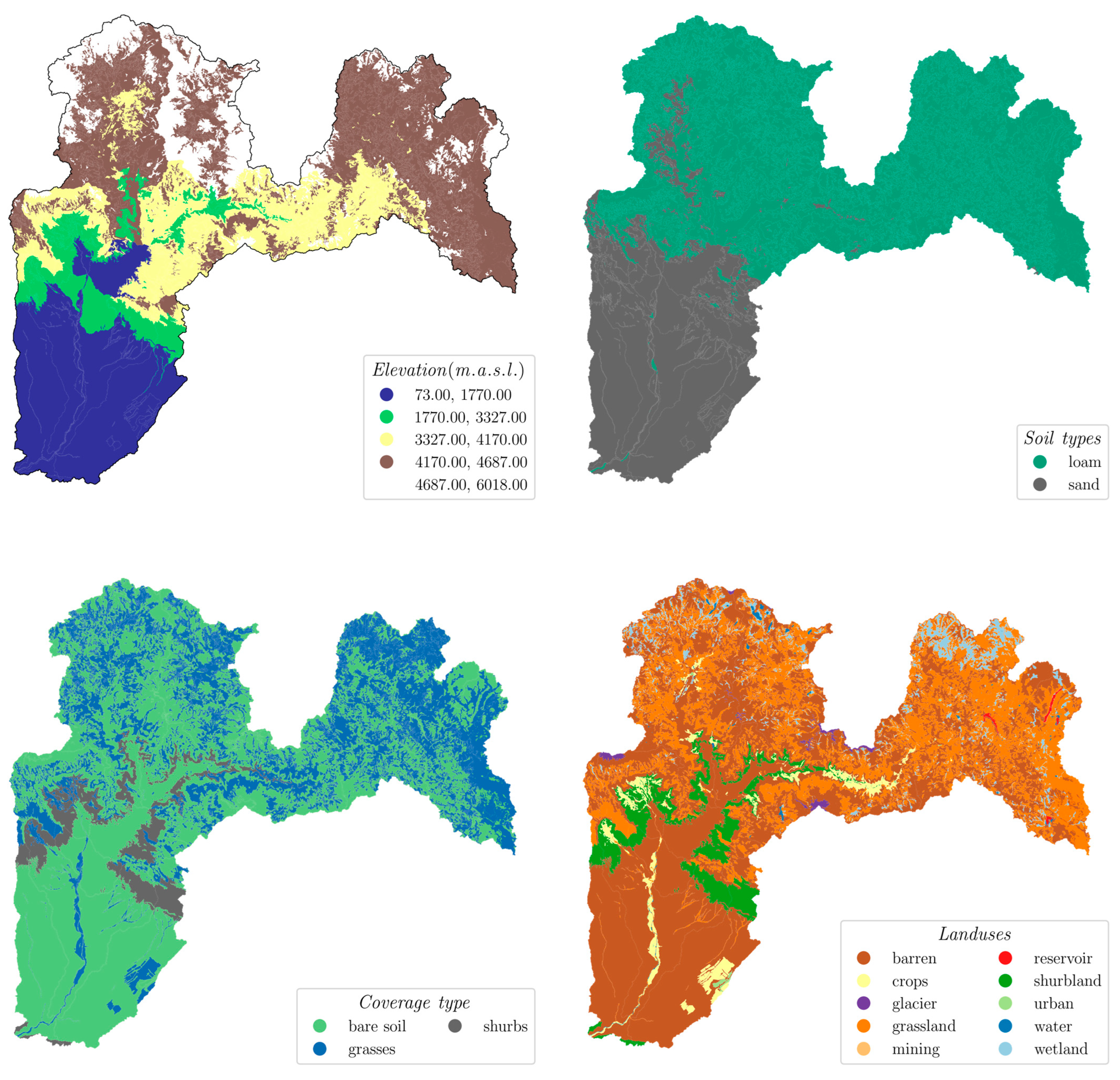
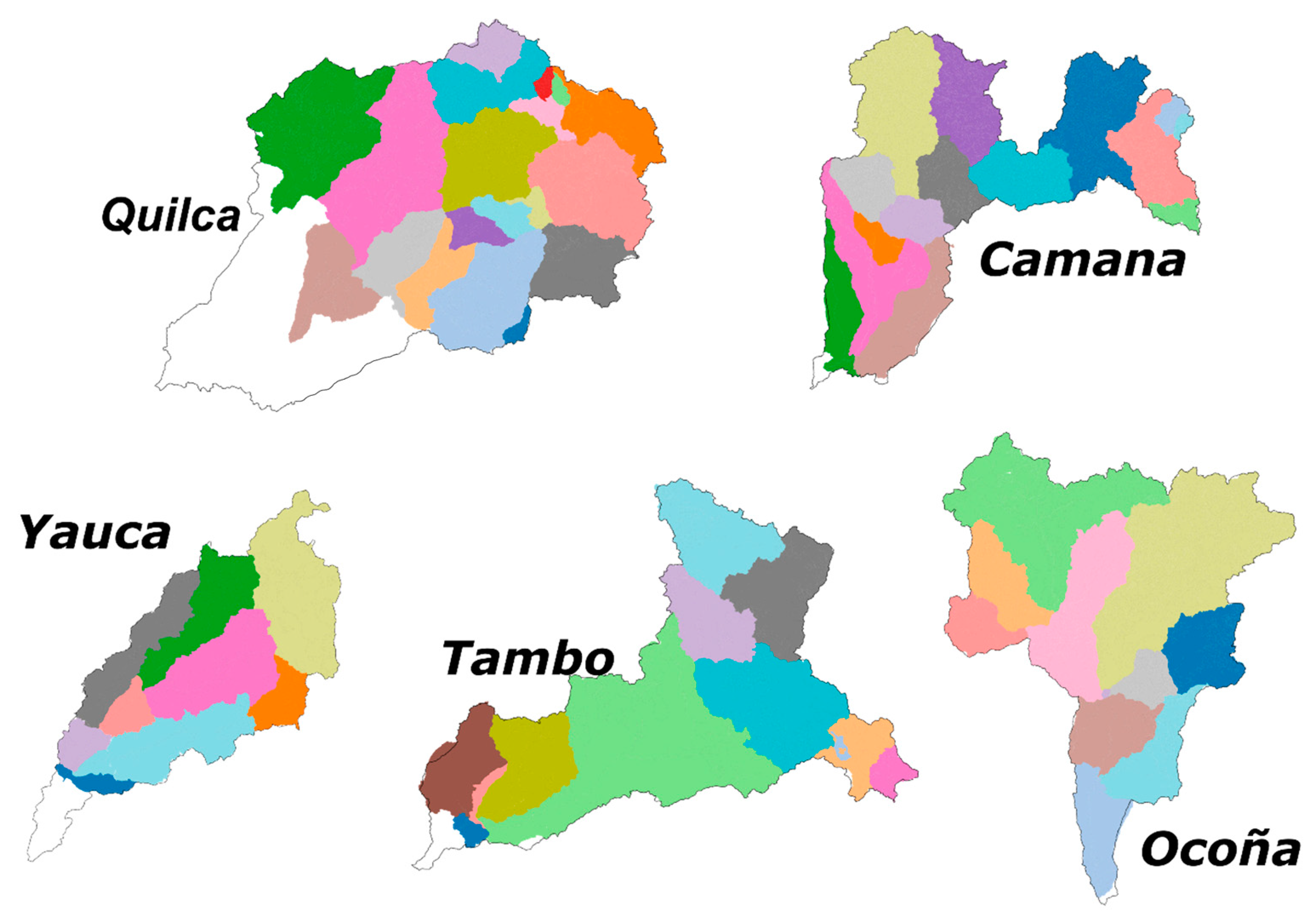
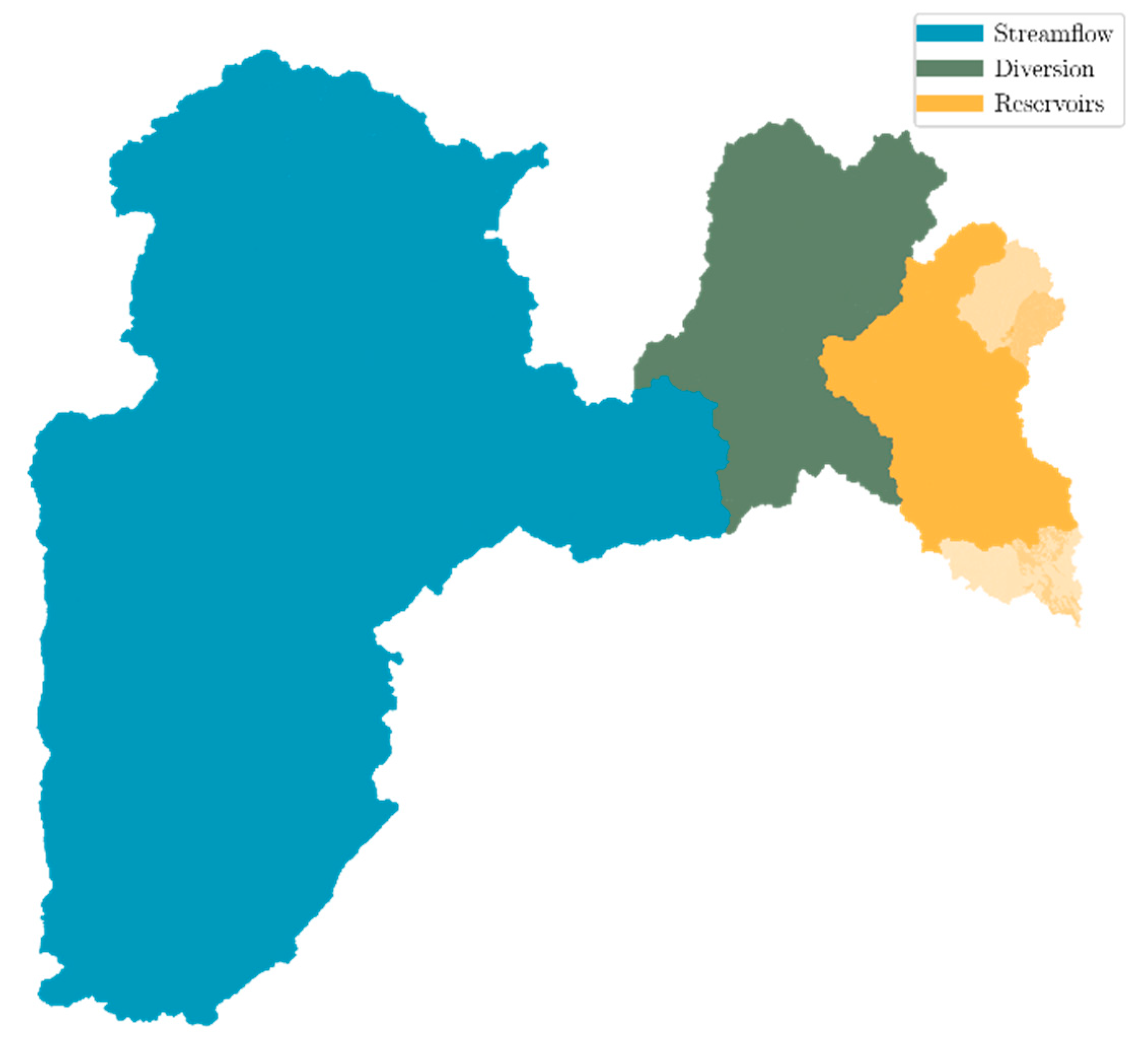
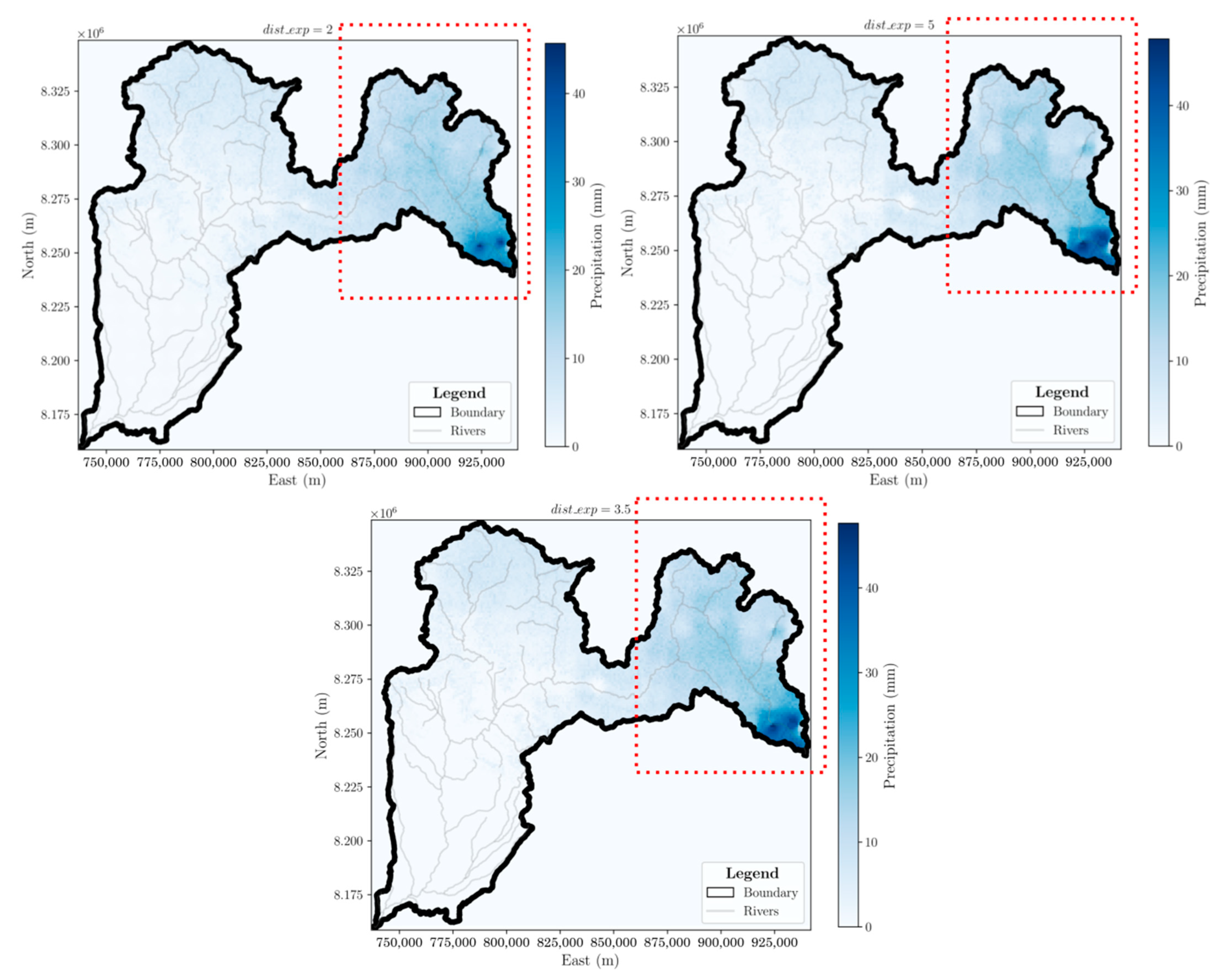
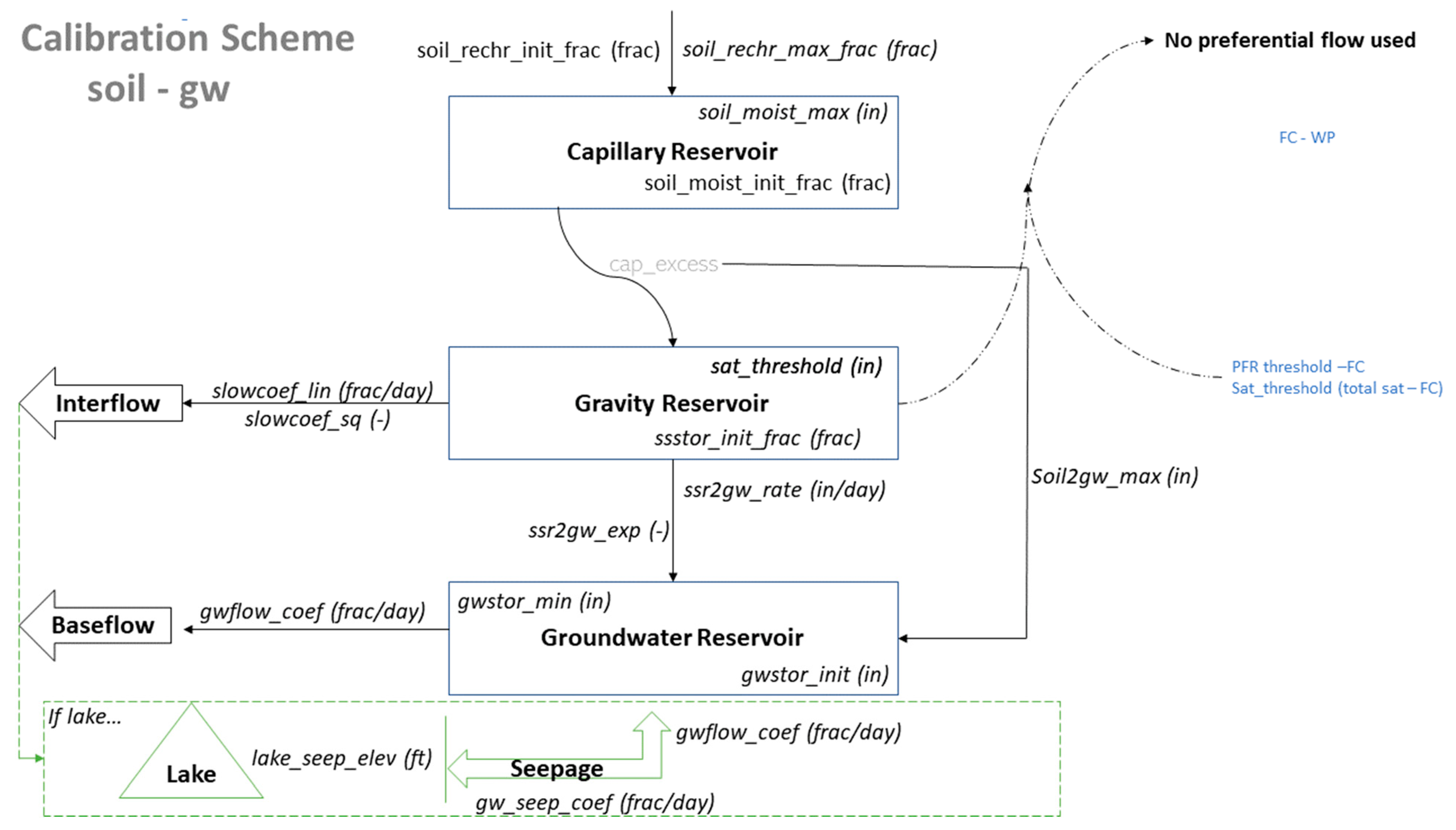




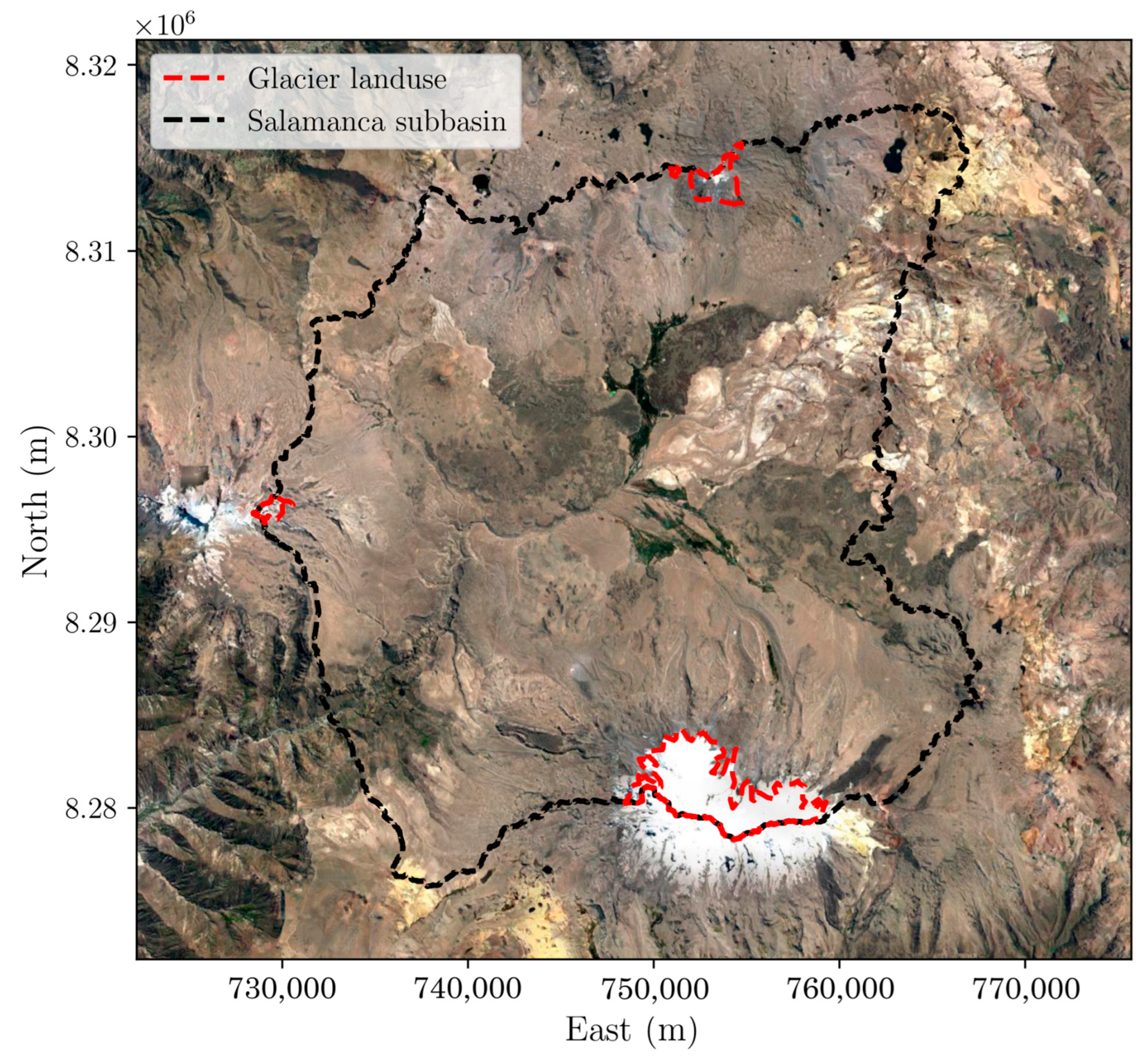

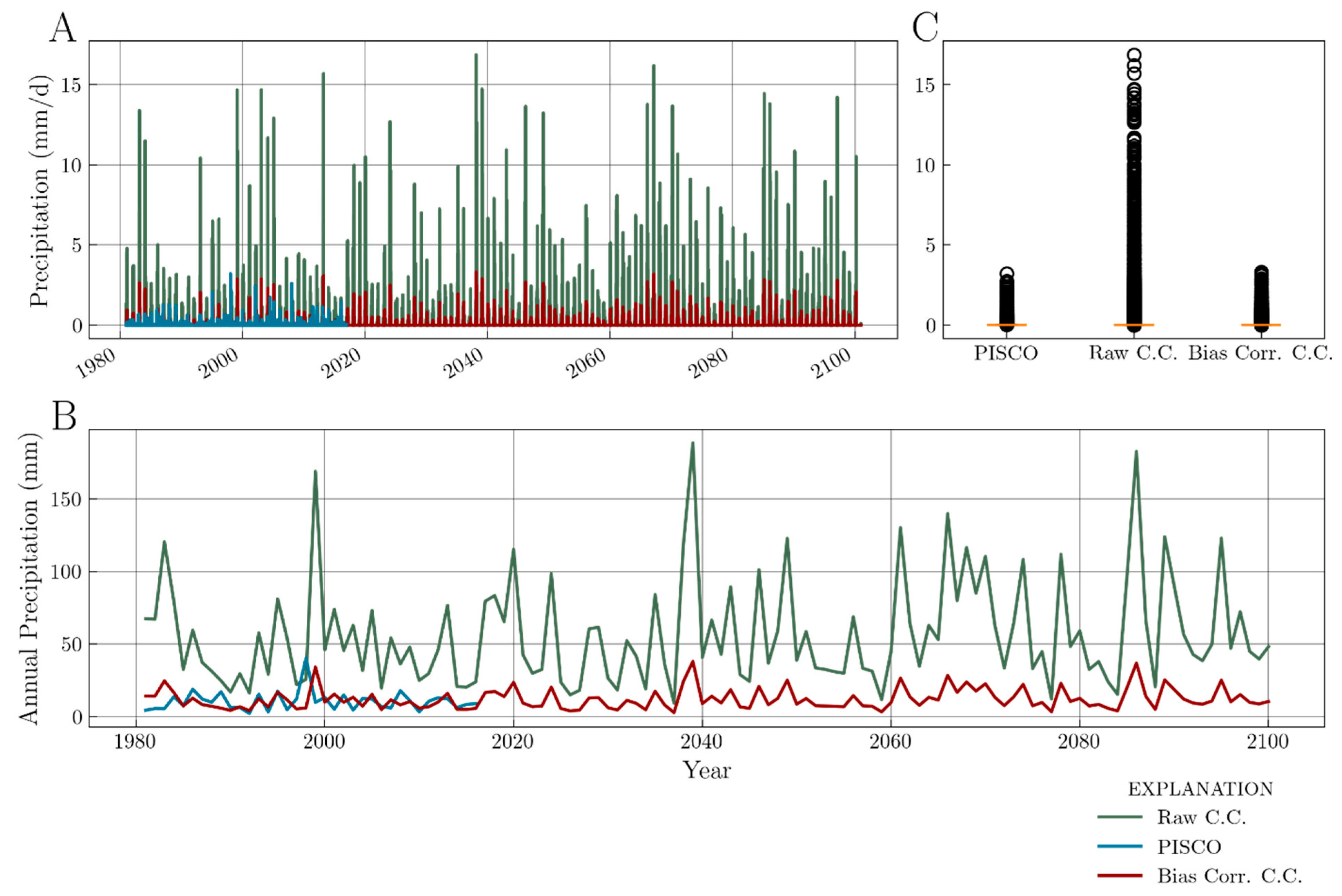
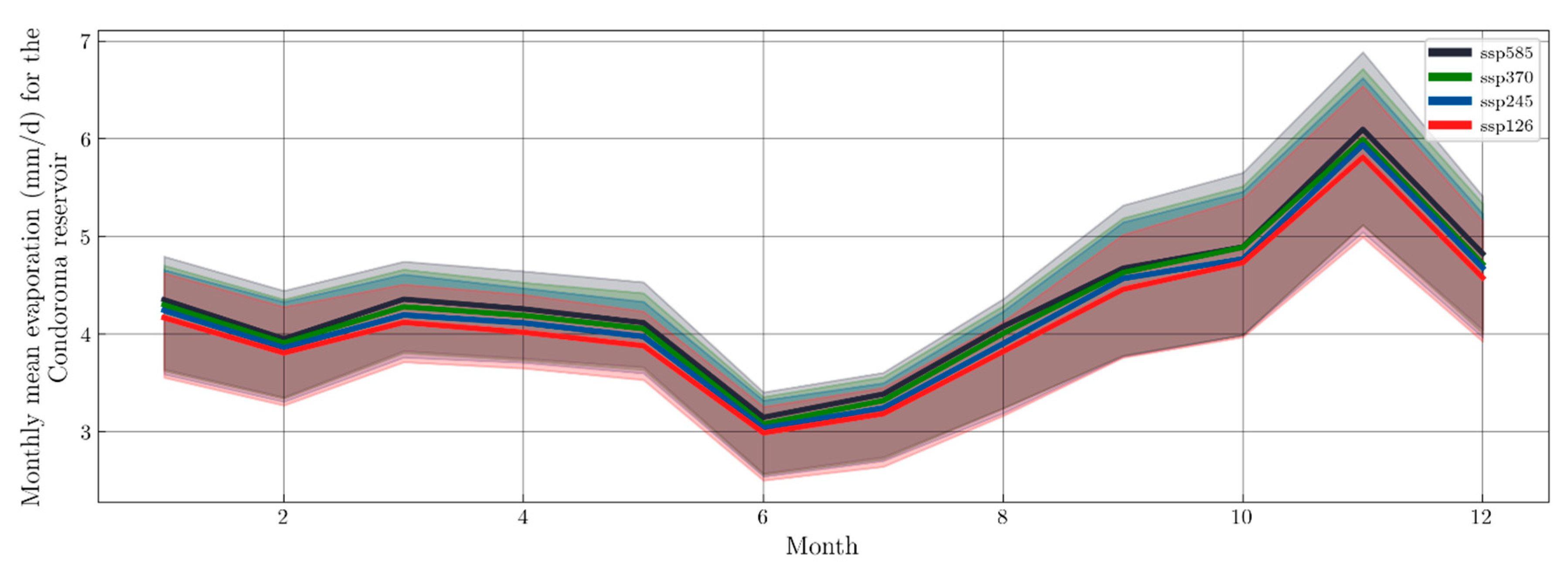
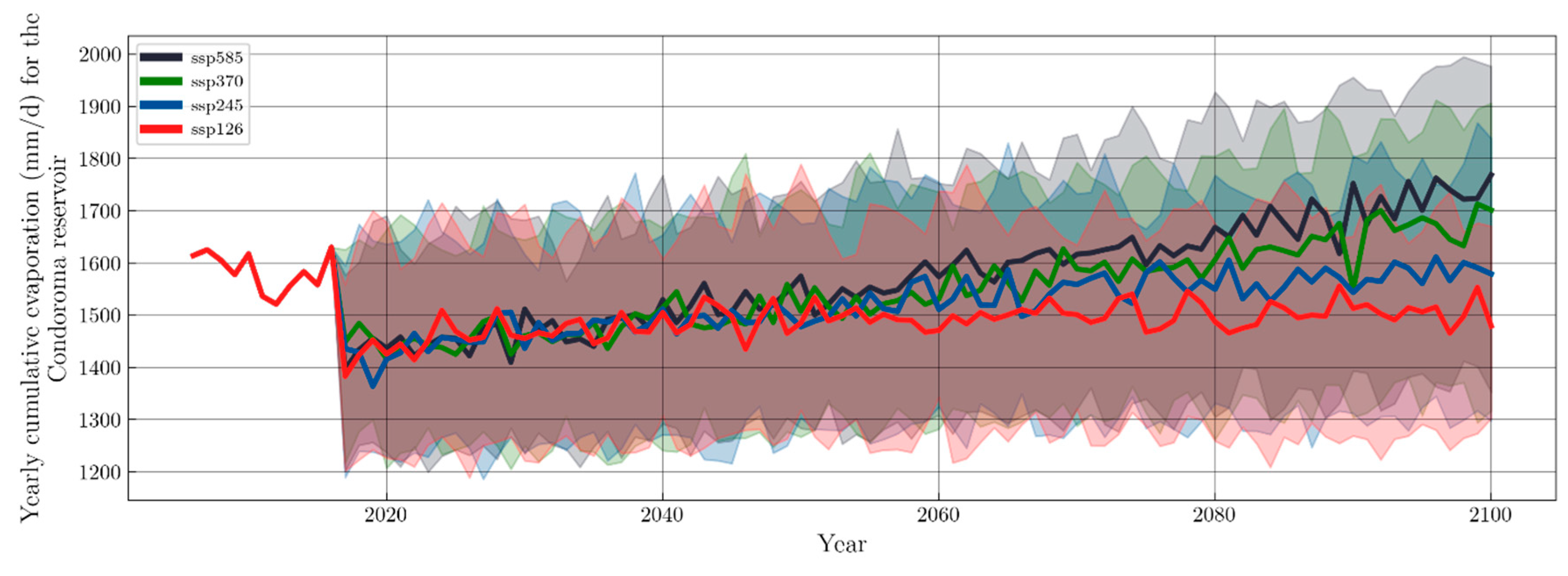
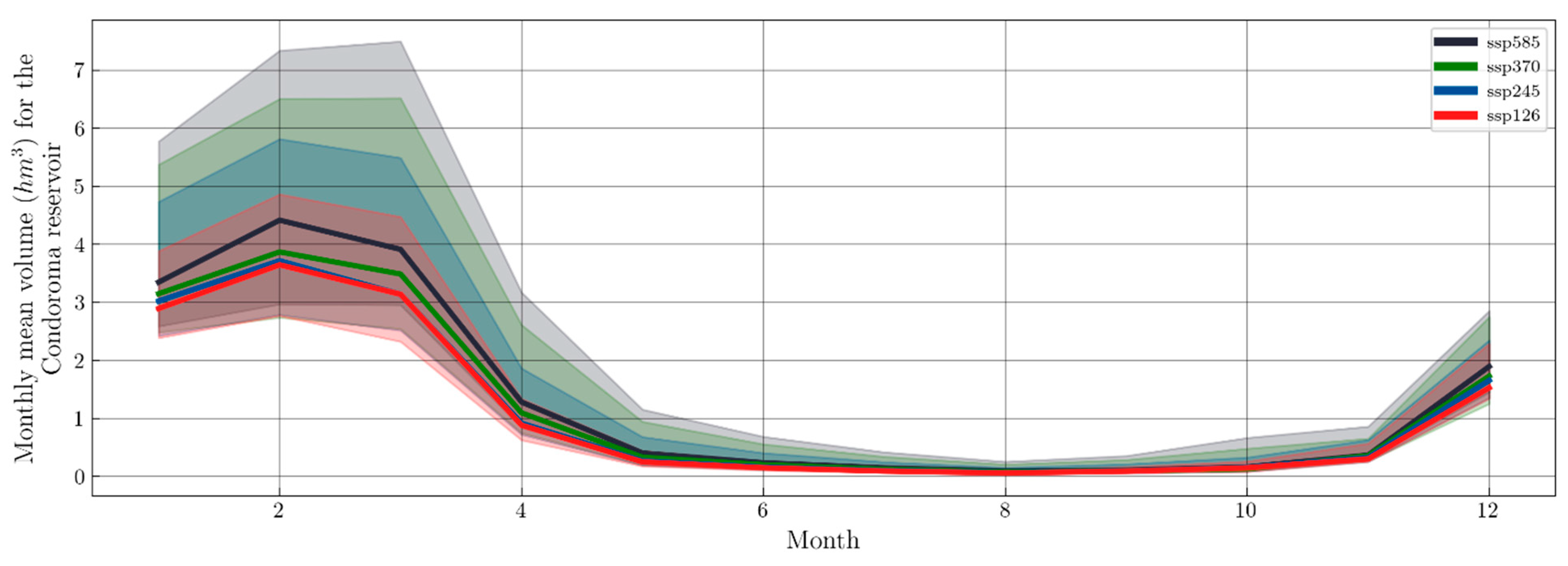
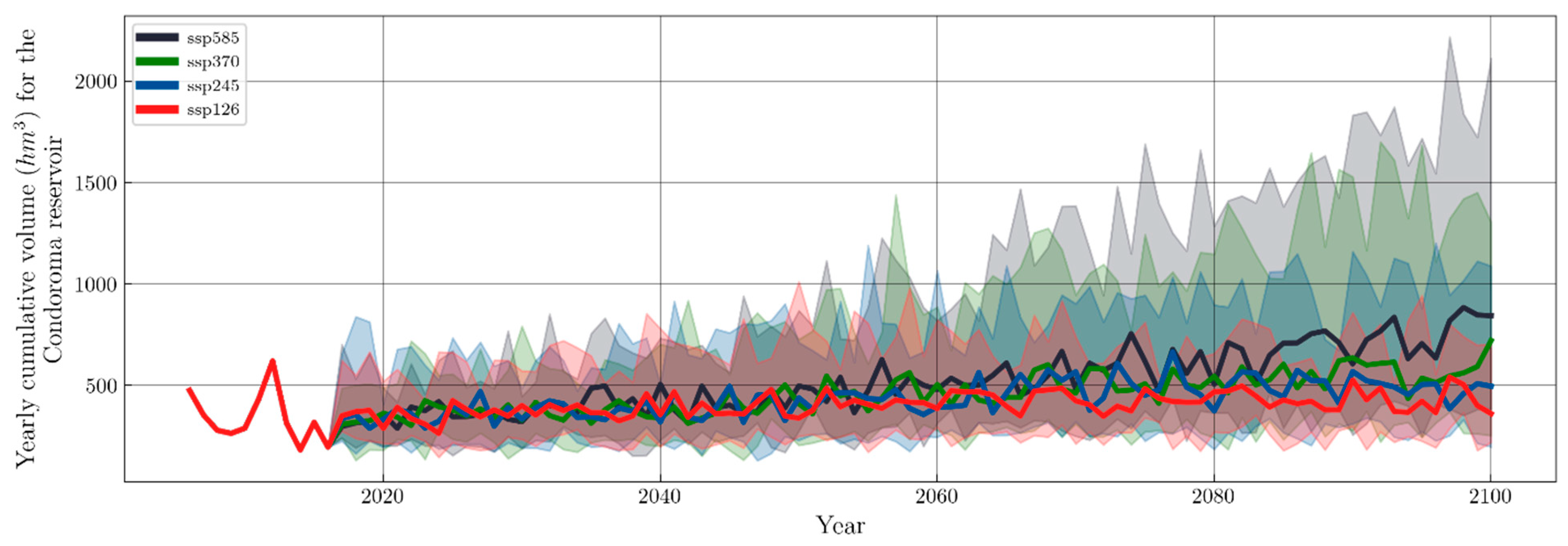
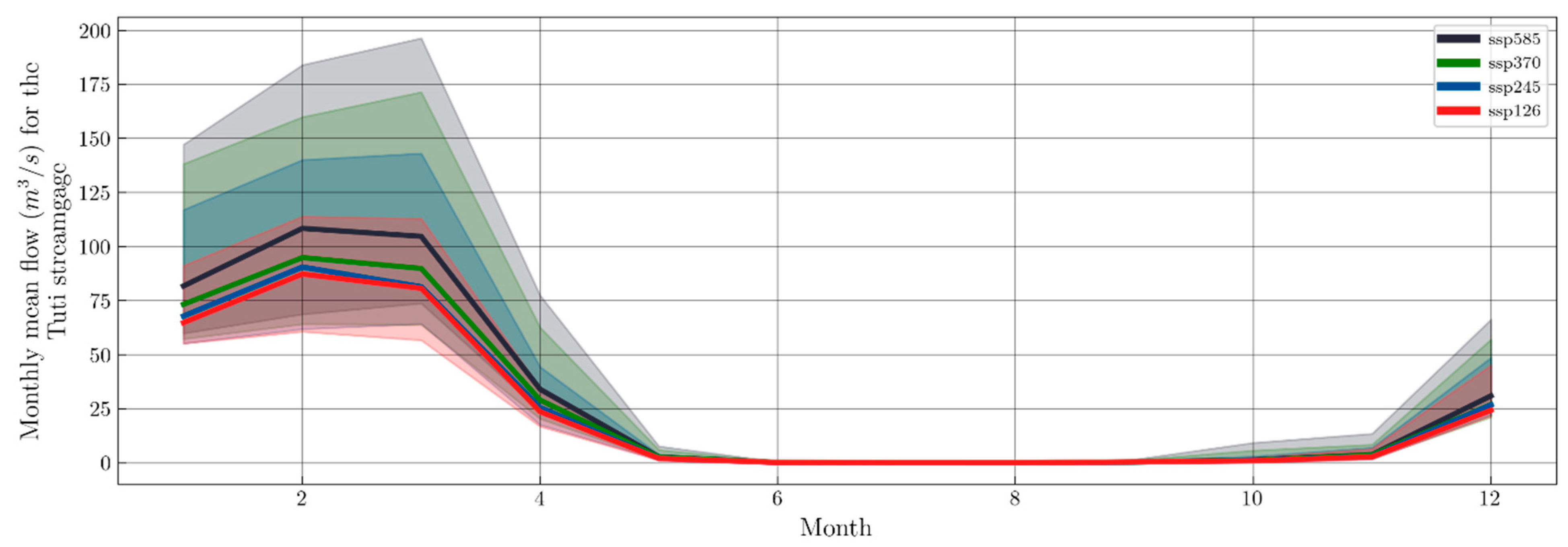
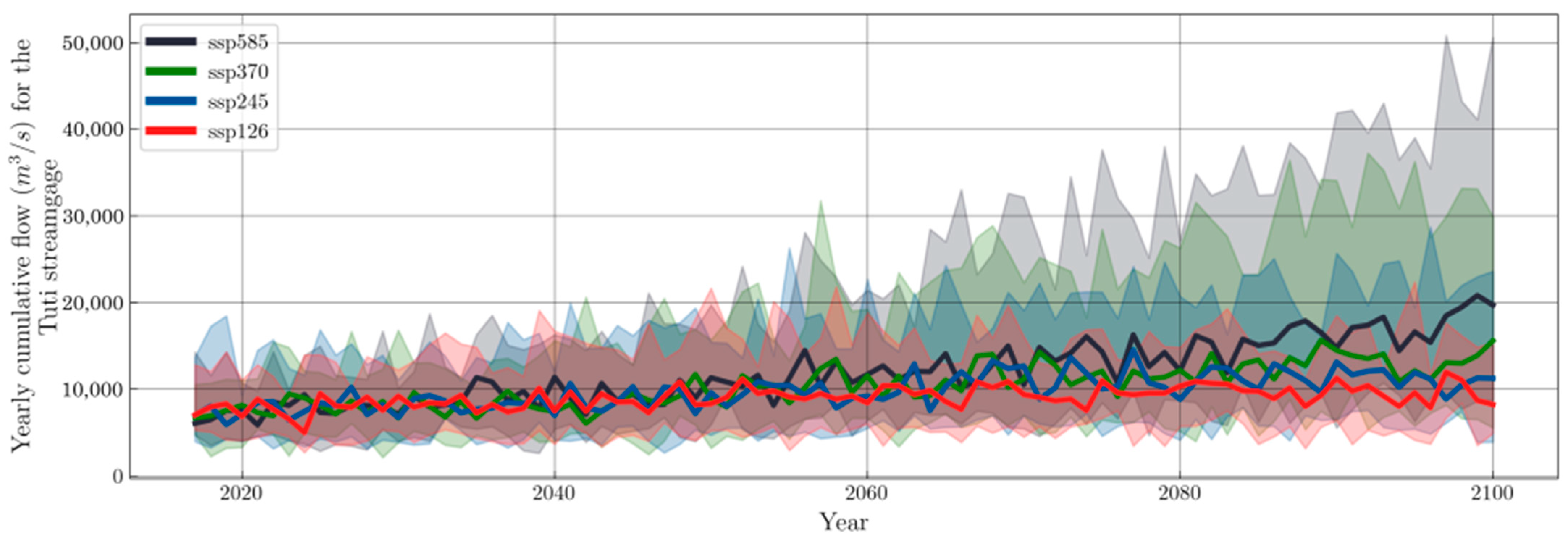
| Watershed | Area (km2) | River Length (Km) | Annual Precipitation (mm) | T Max (°C) | T Min (°C) | Relative Humidity (%) | Wind Speed (m/s) | Simulated Reservoirs | Simulated Water Diversions | Population |
|---|---|---|---|---|---|---|---|---|---|---|
| Tambo | 13,022 | 297 | 335.35 | 18.2 | 0.4 | 59.5 | 2.2 | 1 | 1 | 81,291 |
| Quilca | 13,530 | 275 | 315.5 | 27.6 | −7.3 | 59.8 | 3.3 | 4 | 0 | 1,149,002 |
| Camana | 17,049 | 413 | 360.9 | 27.5 | −6.9 | 60.1 | 9.5 | 4 | 2 | 170,998 |
| Ocoña | 15,998 | 283 | 397 | 25 | −3.3 | 60 | 3.5 | 0 | 0 | 58,387 |
| Yauca | 4312 | 183 | 350 | 19 | 5 | 60.3 | 3.7 | 0 | 0 | 27,530 |
| Reservoir | Watershed | Year of Construction | Effective Storage (Hm3) | Dead Storage (Hm3) |
|---|---|---|---|---|
| Pasto Grande | Tambo | 1998 | 161.28 | 38.72 |
| El Pañe | Camana | 1962–1964 | 99.60 | 41.3 |
| Bamputañe | Camana | 2009 | 40 | 1.12 |
| Dique los Españoles | Camana | 1992 | 9.09 | 2.84 |
| Condoroma | Camana | 1981–1985 | 259 | 16 |
| Pillones | Quilca | 2006 | 78.50 | 3.24 |
| Challhuanca | Quilca | 2010 | 25 | 0.4 |
| El Frayle | Quilca | 1956–1958 | 127.24 | 8.0 |
| Aguada Blanca | Quilca | 1968–1972 | 30.43 | 5.32 |
| Yauca | Ocoña | Camana | Quilca | Tambo | |
|---|---|---|---|---|---|
| ANA area (km2) | 4.32 × 103 | 1.60 × 104 | 1.73 × 104 | 1.35 × 104 | 1.30 × 104 |
| Percentage of the area covered by the delineation (%) | 94 | 99 | 99 | 77 | 98 |
| N° HRUs | 58 | 80 | 5315 | 2703 | 70 |
| N° Subbasins | 9 | 11 | 15 | 19 | 12 |
| Watershed | Subbasin Simulation | Starting Date (d/m/y) | Data Available from Starting Date to End Date (%) | NSE | RMSE |
|---|---|---|---|---|---|
| Yauca | Yauca | 1 January 2014 | 51 | 0.56 | 9.43 m3/s |
| Ocoña | Ocoña | 1 January 2001 | 29 | 0.73 | 57.88 m3/s |
| Ocoña | Salamanca | 1 January 2001 | 59 | 0.35 | 2.02 m3/s |
| Camana | Pañe (reservoir) | 1 January 2006 | 100 | 0.8 | 12.27 hm3 |
| Camana | Bamputañe (reservoir) | 1 February 2010 | 100 | 0.73 | 6.32 hm3 |
| Camana | Dique los Españoles (reservoir) | 1 January 2006 | 100 | 0.15 | 2.64 hm3 |
| Camana | Condoroma (reservoir) | 1 January 2006 | 100 | 0.8 | 29.95 hm3 |
| Camana | Tuti (diversion) | 1 January 2006 | 100 | 0.87 | 17.33 m3/s |
| Camana | Huatipa | 1 January 2006 | 67 | 0.86 | 44.92 m3/s |
| Camana | Hacienda Pampata | 1 January 2006 | 52 | 0.63 | 45.44 m3/s |
| Quilca | Challhuanca (reservoir) | 9 January 2009 | 100 | 0.83 | 3.30 hm3 |
| Quilca | Pillones (reservoir) | 10 January 2007 | 100 | 0.98 | 3.23 hm3 |
| Quilca | El Frayle (reservoir) | 1 January 2006 | 100 | 0.75 | 280 hm3 |
| Quilca | Aguada Blanca (reservoir) | 9 January 2009 | 100 | -46.6 | 41.14 hm3 |
| Quilca | Sumbay | 1 January 2006 | 100 | 0.79 | 2.69 m3/s |
| Quilca | Puente del Diablo | 1 January 2006 | 53 | 0.67 | 6.23 m3/s |
| Quilca | Tingo Grande | 1 January 2006 | 63 | 0.74 | 1.01 m3/s |
| Quilca | Pitay | 1 January 2006 | 100 | 0.72 | 2.77 m3/s |
| Tambo | Pasto Grande (reservoir) | 1 January 1997 | 99 | 0.6 | 20.33 hm3 |
| Tambo | Santa Rosa | 1 January 1997 | 97 | 0.71 | 1.37 m3/s |
Disclaimer/Publisher’s Note: The statements, opinions and data contained in all publications are solely those of the individual author(s) and contributor(s) and not of MDPI and/or the editor(s). MDPI and/or the editor(s) disclaim responsibility for any injury to people or property resulting from any ideas, methods, instructions or products referred to in the content. |
© 2023 by the authors. Licensee MDPI, Basel, Switzerland. This article is an open access article distributed under the terms and conditions of the Creative Commons Attribution (CC BY) license (https://creativecommons.org/licenses/by/4.0/).
Share and Cite
Quiroz, J.A.; Garcia-Chevesich, P.A.; Martínez, G.; Martínez, K.; Tejada-Purizaca, T.; Murray, K.E.; McCray, J.E. Water Resources Evaluation and Sustainability Considering Climate Change and Future Anthropic Demands in the Arequipa Region of Southern Peru. Sustainability 2023, 15, 16270. https://doi.org/10.3390/su152316270
Quiroz JA, Garcia-Chevesich PA, Martínez G, Martínez K, Tejada-Purizaca T, Murray KE, McCray JE. Water Resources Evaluation and Sustainability Considering Climate Change and Future Anthropic Demands in the Arequipa Region of Southern Peru. Sustainability. 2023; 15(23):16270. https://doi.org/10.3390/su152316270
Chicago/Turabian StyleQuiroz, Jonathan A., Pablo A. Garcia-Chevesich, Gisella Martínez, Kattia Martínez, Teresa Tejada-Purizaca, Kyle E. Murray, and John E. McCray. 2023. "Water Resources Evaluation and Sustainability Considering Climate Change and Future Anthropic Demands in the Arequipa Region of Southern Peru" Sustainability 15, no. 23: 16270. https://doi.org/10.3390/su152316270
APA StyleQuiroz, J. A., Garcia-Chevesich, P. A., Martínez, G., Martínez, K., Tejada-Purizaca, T., Murray, K. E., & McCray, J. E. (2023). Water Resources Evaluation and Sustainability Considering Climate Change and Future Anthropic Demands in the Arequipa Region of Southern Peru. Sustainability, 15(23), 16270. https://doi.org/10.3390/su152316270










